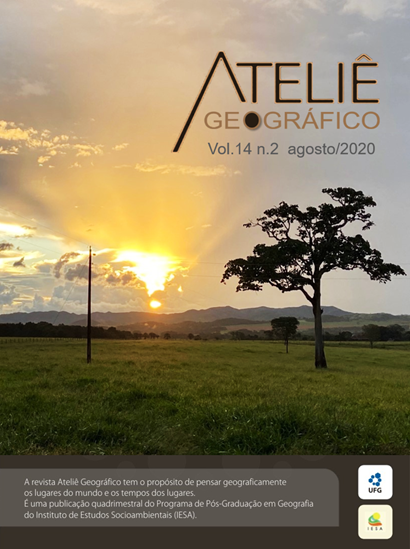Palm swamps of the Araripe Plateau: subspaces of exception in the semiarid of the state of Ceará, Brazil
DOI:
https://doi.org/10.5216/ag.v14i2.62824Abstract
In the region of Cariri Ceará, the natural singularities, especially in the areas of direct influence of Araripe Plateau, reaffirm their exception character within the semi-arid region of northeastern Brazil and define the palm swamps as exception subspaces. In this article, we seek to present the natural characteristics of the palm swamps of the Araripe Plateau, which are possess Hyperdystric Umbric Subaquatic Gleysols (WRB, 2014), acid, very weathered, with predominance of negative charges. These soils support buritis, among other freatophytes, which are heritage of a complex paleoecologica and paleoclimate evolution, maintained today by the influences of the exudation zones. The palm swamps of the Araripe Plateau are classified from the geomorpholocial point of view, belonging to 4 (four) specific types: Patamar, Chapadão drepression, foothill and hillside, they form at these topographic positions due to the water table depth, having its evolutionary process related to the erosion and escarpment recoil. The palm swamps of the Araripe Plateau are currently refuges and strained by the semiarid climate.
Keywords: Plateau of the Araripe; exception subspaces; palm swamps; Cariri Ceará.
Downloads
Downloads
Published
How to Cite
Issue
Section
License
Autores que publicam nesta revista concordam com os seguintes termos:- Autores mantém os direitos autorais e concedem à revista o direito de primeira publicação, com o trabalho simultaneamente licenciado sob a Licença Creative Commons Attribution que permite o compartilhamento do trabalho com reconhecimento da autoria e publicação inicial nesta revista.
- Os autores não serão remunerados pela publicação de trabalhos na Revista Ateliê Geográfico. Além disso, os conteúdos publicados são de inteira e exclusiva responsabilidade de seus autores, ainda que reservado aos editores o direito de proceder a ajustes textuais e de adequação às normas da publicação.
- Autores têm permissão e são estimulados a divulgar seu trabalho online (ex.: em repositórios institucionais ou na sua página pessoal), já que isso pode gerar alterações produtivas, bem como aumentar o impacto e a citação do trabalho publicado (Veja O Efeito do Acesso Livre).


